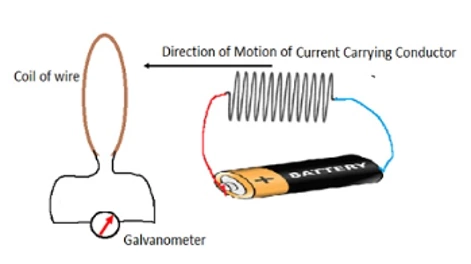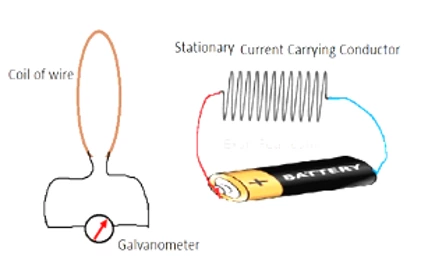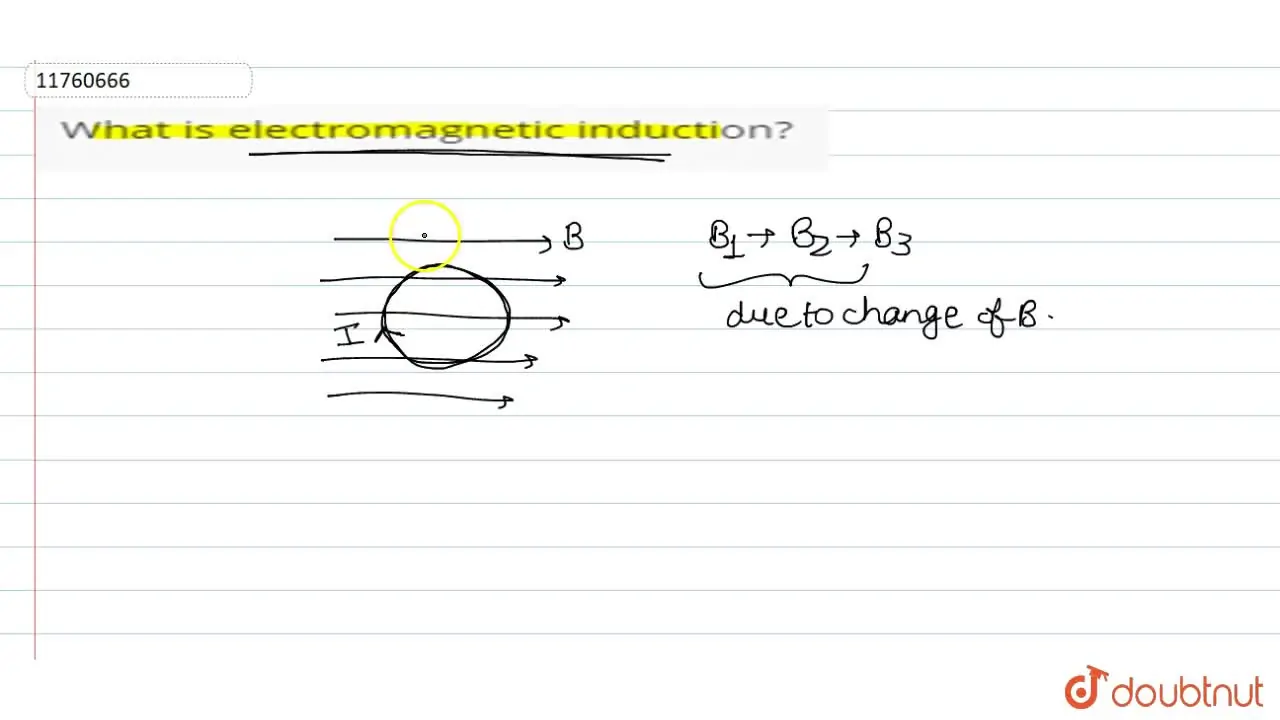What is electromagnetic induction?
Electromagnetic Induction
The process of producing induced current in a closed circuit or in a coil by changing the magnetic field linked with the coil is called electromagnetic induction. At whatever point there is a relative movement between a magnet and a loop, a current is prompted in the curl because of the adjustment in the attractive field related with it. This procedure of delivering acceptance current is known as electromagnetic induction
Case 1
Let north pole goes inward, then the galvanometer shows deflection toward right (say).
Case 2
When north pole goes away, then it can be seen that galvanometer shows deflection toward left(in opposite direction)
Case 3
When south pole of magnet goes away from the coil, the galvanometer shows deflection toward right.
Case 4
When south pole goes inward, the deflection toward left.
Case 1
When switch is on the primary coil, the magnetic field linked with secondary coil changes and the galvanometer shows deflection toward right (say).
Case 2
When there is a steady current in the primary coil the galvanometer will show no deflection.
Case 3
When the switch is off in the primary coil, magnetic field in coil B also change and the galvanometer shows deflection in the opposite direction.
Faradays law of electromagnetic induction
Faraday's Experiment-1

- Take a wire, a bar magnet and a galvanometer
- Now try to move the magnet towards the coil of wire.
- Here the galvanometer moves to indicate a current in the wire.
- When the direction of the magnet is reversed, the current reverses (indicated by the galvanometer needle swaying in the opposite direction)
- When the speed of movement of the magnet changes, then the galvanometer deflects faster.
Conclusion : Moving a magnet towards a coil induces a current in the coil whose direction and magnitude is given by the galvanometer.
Faraday's Experiment-2

- Take a wire, a current carrying conductor/wire and a galvanometer
- Move the current carrying conductor towards the coil of wire. (Magnet is replaced by current carrying conductor)
- The galvanometer moves to indicate a current in the wire.
Conclusion: Current is induced in a coil when a current carrying conductor is brought in its vicinity.
Faraday Experiment-3

- Take a wire, a current carrying conductor/wire and a galvanometer
- Do not move the current carrying conductor. Keep it stationary
- The galvanometer moves to indicate a current in the wire. In general, the current carrying conductor/magnet is called primary coil. The conductor in which the current is induced is called the secondary coil.
Conclusion: Relative motion between the current carrying conductor and the wire is not mandatory for inducing current in the wire.
What are eddy currents?
Eddy currents are currents and flows which circulate in conductors like swirling eddies in a stream. They are initiated by changing attractive fields and stream in shut circles, opposite to the plane of the attractive field. They can be made when a conductor is traveling through an attractive field, or when the attractive field encompassing a stationary conductor is changing for example anything which brings about the conductor encountering an adjustment in the force or bearing of an attractive field can create whirlpool flows. The size of the swirl current is relative to the size of the attractive field, the region of the circle and the pace of progress of attractive transition, and contrarily corresponding to the resistivity of the transmitter.
Like any present coursing through a conductor, a whirlpool current will deliver its very own attractive field. Lenz's Law expresses that the heading of attractively initiated current, similar to a swirl current, will be with the end goal that the attractive field delivered will restrict the difference in attractive field which made it. This opposition made by the contradicting attractive fields is abused in vortex current braking, which is generally utilized as a technique for halting pivoting power devices and rollercoasters.
In the outline beneath, the conductive metal sheet (speaking to the moving rollercoaster vehicle or force apparatus for example), moves past a stationary magnet. As the sheet moves past the left edge of the magnet, it will feel an expansion in attractive field quality, instigating counter-clockwise whirlpool flows. These flows produce their very own attractive fields and as per Lenz's Law, the course will be upwards for example contradicting the outer attractive field, making attractive drag. At the other edge of the magnet, the sheet will leave the attractive field and the difference in field will be the other way, therefore instigating clockwise vortex flows which at that point produce an attractive field acting downwards. This will pull in the outside magnet, likewise creating drag. These drag powers moderate the moving sheet, giving the braking. An electromagnet can be utilized for the outside magnet, which means it is conceivable to fluctuate the quality of the braking applied by modifying the current through the electromagnet's curls. A bit of leeway of whirlpool braking is that it is contactless, so brings about no mechanical wear. Be that as it may, vortex braking isn't reasonable for low speed braking and because the conductor must be moving, swirl brakes can't hold protests in stationary positions. In this way, it is frequently important to likewise utilize a conventional erosion brake.

Eddy currents can also be removed by cracks or slits in the conductor, which break the circuit and prevent the current loops from circulating. This implies vortex flows can be utilized to distinguish surrenders in materials. This is called nondestructive testing and is frequently utilized in planes. The attractive field created by the whirlpool flows is estimated, where an adjustment in the field uncovers the nearness of an abnormality; a deformity will lessen the size of the swirl current, which thus decreases the attractive field quality.
Another application of eddy currents is magnetic levitation. Conductors are presented to shifting attractive fields which prompt vortex flows inside the conductor and produce a frightful attractive field, pushing the magnet and conductor separated. This rotating attractive field can be brought about by relative movement between the magnet and conductor (by and large the magnet is stationary and the conductor moves) or with an electromagnet applied with a fluctuating current to differ the attractive field quality.




Related Playlists
- BOOK - PRADEEPCHAPTER - MAGNETIC EFFECTS OF ELECTRIC CURRENTEXERCISE - Short Answer Questions (Additional)25videos
MAGNETIC EFFECTS OF ELECTRIC CURRENT
- BOOK - PRADEEPCHAPTER - MAGNETIC EFFECTS OF ELECTRIC CURRENTEXERCISE - C. (short answer)18videos
MAGNETIC EFFECTS OF ELECTRIC CURRENT
- BOOK - PRADEEPCHAPTER - MAGNETIC EFFECTS OF ELECTRIC CURRENTEXERCISE - Long Answer Questions8videos
MAGNETIC EFFECTS OF ELECTRIC CURRENT
- BOOK - PRADEEPCHAPTER - ELECTRICITYEXERCISE - (Mock Test)Sec - B6videos
ELECTRICITY
- BOOK - PRADEEPCHAPTER - REFLECTION AND REFRACTIONEXERCISE - NCERT EXEMPLAR PROBLEMS19videos
REFLECTION AND REFRACTION
Similar Questions
Why is electromagnetic induction so called?
View SolutionWhy is electromagnetic induction so called?
View SolutionWhich of the following best explains electromagnetic induction ?
View SolutionWhat condition is necessary for the production of current by electromagnetic induction ?
View SolutionWhich of the following phenomenon makes use of electromagnetic induction?
View SolutionElectromagnetic induction means
View SolutionElectromagnetic induction means
View SolutionAccording to Lenz's law of electromagnetic induction
View SolutionAccording to Faraday's law of electromagnetic induction
View SolutionWhat is the basis of Lenz's law of electromagnetic induction.
View Solution


